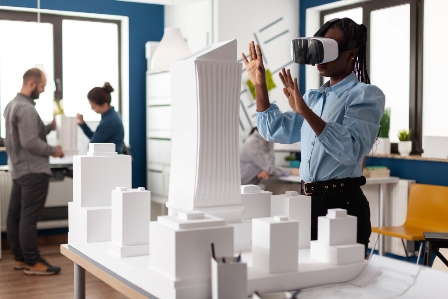In the fast-evolving landscape of the 21st century, our homes are no longer just shelters; they are becoming dynamic spaces shaped by cutting-edge technologies. This article delves into the exciting realm of the future of living, exploring various tech trends that are reshaping home design.
In the not-so-distant future, the concept of home design is undergoing a profound transformation. We are witnessing an era where living spaces are no longer static but adaptive, thanks to the integration of cutting-edge technologies. Staying informed about these trends is crucial for anyone looking to create a modern and functional living environment.
Smart Homes: Revolutionizing Daily Living
The advent of smart home technology has brought about a revolution in how we interact with our living spaces. The seamless integration of Artificial Intelligence (AI) and Internet of Things (IoT) devices allows for unprecedented control and automation. Imagine a home where your preferences are learned and your daily routine is optimized for efficiency – that’s the promise of smart homes.
Sustainable Living: Eco-Friendly Home Designs
With an increasing awareness of environmental issues, sustainable living is a key trend in home design. Green technology is finding its way into every aspect of construction, from energy-efficient appliances to the use of eco-friendly materials. The future of home design is not just aesthetically pleasing but also environmentally conscious.
Virtual and Augmented Reality in Home Design
The days of imagining a home through blueprints are long gone. Virtual and augmented reality technologies are making it possible to take virtual tours of homes before they are even built. This not only aids in better planning but also allows homeowners to visualize the final look and feel of their living spaces.
Robotics in Home Automation
Enter the era of robotic assistance in daily chores. From automated cleaning systems to furniture that transforms based on need, robotics is playing a significant role in automating mundane tasks, providing homeowners with more time for leisure and relaxation.
Adaptive Architecture for Changing Needs
The concept of adaptive architecture revolves around creating living spaces that can evolve with changing needs. Modular and flexible designs enable homeowners to adapt their homes to different life stages, ensuring that the living space remains functional and relevant.
The Role of 3D Printing in Construction
Traditional construction methods are being challenged by the innovative use of 3D printing. This technology allows for the printing of personalized home components, reducing construction waste and costs. The result is not only cost-effective but also a more sustainable approach to building homes.
Artificial Intelligence in Interior Design
Artificial Intelligence is not only streamlining daily tasks but also influencing interior design. AI-driven design suggestions based on personal preferences are making it easier for homeowners to create spaces that reflect their unique tastes and styles.
Biophilic Design: Bringing Nature Indoors
Biophilic design aims to create living spaces that mimic nature, promoting a connection with the outdoors. Incorporating natural elements, such as green walls and natural light, has a positive impact on mental well-being, contributing to healthier and happier living environments.
Quantum Computing and Home Security
As homes become smarter, the need for advanced security measures grows. Quantum computing is poised to revolutionize home security by providing advanced encryption that can protect sensitive data and personal privacy in the era of interconnected smart homes.
Health and Wellness Tech in Home Design
The integration of health and wellness tech within homes is a trend that focuses on creating environments that promote well-being. From fitness tech integrated into living spaces to wellness-oriented home designs, the future of living involves spaces that actively contribute to residents’ health.
The Influence of Nanotechnology in Home Materials
Nanotechnology is making waves in home design by introducing self-healing and self-cleaning materials. These materials not only enhance durability but also contribute to sustainability by reducing the need for frequent replacements and maintenance.
Voice-Activated Home Systems
Voice-activated systems are becoming commonplace in modern homes. From controlling lights to managing home security, these systems offer enhanced accessibility and convenience, making daily tasks as simple as issuing a command.
The Future of Multi-Functional Spaces
The constraints of limited living space are being addressed through the concept of multi-functional spaces. Rooms are designed to serve diverse purposes, maximizing utility without compromising on aesthetics.
Challenges and Ethical Considerations
While the future of living is exciting, it comes with its set of challenges and ethical considerations. Privacy concerns regarding the use of smart home technology and ethical considerations in designing futuristic homes raise important questions that need careful consideration.
FAQs
Smart homes employ advanced security measures, but users must also take precautions such as regular software updates and strong passwords.
Biophilic design enhances well-being by incorporating natural elements, reducing stress, and promoting a connection with nature.
While 3D printing is currently used for specific components, advancements are being made toward using it for entire home construction.
Multi-functional spaces may pose challenges in maintaining a cohesive aesthetic and functional balance.
Quantum computing provides advanced encryption, ensuring a higher level of security for smart homes against cyber threats.
Conclusion
The future of living is a fascinating intersection of technology, sustainability, and adaptability. As we embrace cutting-edge tech trends in home design, it’s essential to navigate the challenges with a thoughtful approach. The homes of tomorrow will not only be smart and sustainable but also tailored to the evolving needs and preferences of their inhabitants.


